Home
A comprehensive resource for safe and responsible laser use
US: Air Force develops laser glare protection glasses for pilots
Washington State Patrol pilots successfully test special laser eye protection developed at Wright-Patterson Lab
Story by Mary Pacinda, Air Force Research Laboratory
Aiming a laser at an aircraft is a federal crime that can net offenders up to five years in jail or cost them a $250,000 fine. Even with this heavy potential penalty, laser strikes have become increasingly more common. According to the FAA, 6,852 such incidents were reported in 2020, compared with 385 in 2006, and so far this year, incidents of “joy lasing” are up 20 percent over last year. Cheap and easily obtained, hand-held lasers used as pointers and cat toys are certainly harmless when used as intended. But when they are aimed at the cockpit of an aircraft, they can temporarily blind the pilot — with possibly deadly consequences.
Laser strikes are almost always made at low altitudes when an aircraft is taking off or preparing to land — the two parts of flying that require the most attention from a pilot. Even if the beam of light does not hit the pilot’s eyes directly, it can cause a distraction or even raise an alarm that the plane may have become a target. In addition to the possible adverse effects of these human reactions, slight imperfections in the plane’s windscreen can cause the laser light to spread out, creating a glare that can temporarily obscure all vision inside the cockpit.
Of course, passing a law against any behavior — including pointing a laser at an airplane — seldom puts an end to the behavior. Thus, the best way to avoid disaster from laser strikes is to provide some sort of protection for the pilot. As a result, in recent years several manufacturers have developed laser eye protection (LEP) to meet a growing demand for help from military and law enforcement pilots. But this solution is not without problems of its own.
Most laser eye protection works by filtering out green or red light, the colors most commonly used in handheld lasers. Unfortunately, according to FAA studies and years of pilot experience, this can change the pilot’s ability to accurately read the instrument control panel. A 2019 FAA report suggested that this problem might be fixed by changing the type of lighting in the control panel.
Researchers at the Air Force Research Laboratory recently came up with a better solution, one that was successfully tested on the job by Washington State Patrol pilots.
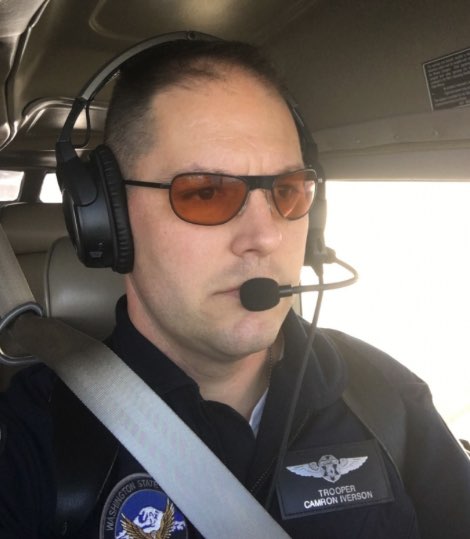
Flight Officer Camron Iverson of the Washington State Patrol tested laser protection lenses formulated at AFRL’s Materials and Manufacturing Directorate. (Photo by Mary Pacinda)
The Personnel Protection Team in AFRL’s Materials and Manufacturing Directorate, headed by Dr. Matthew Lange, used the cockpit compatibility design software developed for Department of Defense LEP and modified it for commercial use. The commercial version, called CALI (Commercial Aviation Low Intensity) filters out the laser light, but not the light coming from the pilot’s instrument panel. “Simply put,” said Lange, “the lenses maximize protection while minimizing the impact to the cockpit.”
US: Los Angeles bans lasers from demonstrations
At an October 27 2020 public meeting, the deputy chief of the L.A. Police Department, said "… we have experienced numerous instances of individuals among these groups intentionally using laser devices and pointers to attempt to blind and cause harm to officers by pointing them purposely at their eyes…. Laser-type devices have no legitimate use outside of the business or educational venues."
The department warned officers to "adjust their vision" to avoid laser beams, and "has since sought to use eyewear and screens" to protect eyes from laser light.
An LAPD spokesperson said thus far in 2020, there had been 20 incidents of laser pointers being used to blind or distract people. Twenty-four people reported eye damage during the incidents, according to the spokesperson. Twenty of them were police officers; some were driving at the time.
The Los Angeles Times reported "In July, LAPD Officer Kyle Rice lost his vision in his right eye, as well as his ability to balance, and was left with migraine-like headaches after he was targeted with a laser pointer after responding to a radio call of a disturbance in Little Tokyo. A person not involved in the dispute between an homeless person and a business owner is accused of pointing the laser at Rice’s eye. An arrest was made in the incident."
According to the L.A. Sentinel, "Some people who spoke during the meeting said it was ironic that the LAPD was asking for a laser-pointer ban at protests, as officers have been photographed using bean bag projectiles that have allegedly caused gruesome injuries to some protesters, such as lost eyeballs and teeth."
Section 55.07 also prohibits items such as wood, pipe, hard signs, baseball bats, aerosol spray (tear gas, mace, pepper spray), firearms, BB guns, tasers, knives, glass bottles, open flame torches, shields of metal, wood or hard plastic, bricks, and rocks.
From the Los Angeles Times, and from the City News Service via the L.A. Sentinel and NBC Los Angeles. More on officer Kyle Rice is here.
US: New technique for scattering laser light on aircraft windscreens
The research was presented by Jason Keleher, Ph.D. and research assistant Daniel Maurer on March 31 2019 at an American Chemical Society meeting in Orlando, Florida. Here is a summary:
"To develop their new approach, the researchers took advantage of liquid crystals -- materials with properties between those of liquids and solid crystals that make them useful in electronic displays. The team placed a solution of liquid crystals called N-(4-methoxybenzylidene)-4-butylaniline (MBBA) between two 1-inch-square panes of glass. MBBA has a transparent liquid phase and an opaque crystalline phase that scatters light. By applying a voltage to the apparatus, the researchers caused the crystals to align with the electrical field and undergo a phase change to the more solid crystalline state.
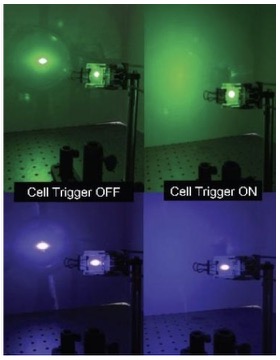
Liquid crystals sandwiched between two1-inch squares of glass (left images) scatter green and blue light on a wall when the cells are triggered by laser illumination (right images). Image credit: Daniel Maurer, Lewis University
"The aligned crystals blocked up to 95 percent of red, blue and green beams, through a combination of light scattering, absorption of the laser's energy and cross-polarization. The liquid crystals could block lasers of different powers, simulating various distances of illumination, as well as light shone at different angles onto the glass.
"In addition, the system was fully automatic: A photoresistor detected laser light and then triggered the power system to apply the voltage. When the beam was removed, the system turned off the power, and the liquid crystals returned to their transparent, liquid state. "We only want to block the spot where the laser is hitting the windshield and then have it quickly go back to normal after the laser is gone," Keleher notes. The rest of the windshield, which was not hit by the laser, would remain transparent at all times.
"Now that the researchers have shown that their approach works, they plan to scale it up from 1-inch squares to the size of an entire aircraft windshield. Initial results have shown that a sensor grid pattern on 2-inch squares of glass will respond only to the section of glass that is illuminated. The team is also testing different types of liquid crystals to find even more efficient and versatile ones that return to the transparent state more quickly once the laser is removed."
Canada: New pilot laser glare protection eyewear using holographic optical filter
The most common laser color reported by pilots is green, representing approximately 90% of reports made to the U.S. Federal Aviation Administration. As of 2019, the most common green is 532 nanometers, produced by low-cost, high-power diode-pumped solid state laser pointers and handhelds.
metaAIR's first offering protects against 532nm green laser light, using holographic "nano-pattern layers". These can precisely reflect 532nm light while allowing high visibility for other wavelengths — crucial for pilots' night vision and for correct color discrimination of cockpit instruments and airport lighting. MTI adds an additional layer to improve color balance and discrimination, as well.
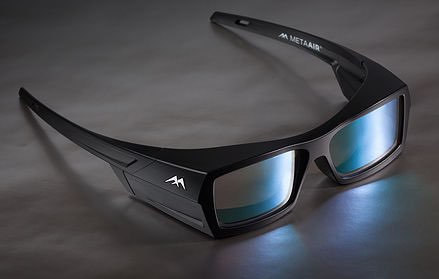
The eyewear is said to have an Optical Density between 2 and 5, meaning that it will attenuate the amount of 532nm light reaching eyes by 100 to 100,000 times. The primary goal is to reduce or eliminate visual interference effects such as flashblindness, glare and distraction. A secondary benefit is that attenuating 532nm light will also help protect against any potential eye injury. (Note that as of February 2019, no documented pilot eye injuries have occurred according to the U.S. FAA, U.K. CAA and Transport Canada after almost 75,000 reports of aircraft illumination. Laser/aviation safety experts consider visual interference to be a more significant safety concern than pilot eye injuries.)
The frame is wider at top, sides and bottom, to block light coming from directions other than the front.
MTI originally developed the holographic laser-reflecting technology for use in windscreens. The goal was to protect pilots without the need for eyewear. However, windscreen modifications require a slow, multi-year process of obtaining governmental and airline approval. In addition, the cost to modify windscreens is much higher than the cost of one or two pairs of eyewear. So eyewear was a natural choice for the first commercially available laser protection product from MTI. According to its metaAIR website, the company may also produce glare shields using the same technology.
MTI is taking pre-orders for its eyewear, distributed by Satair, which will be available "spring 2019."
From MTI's metaAIR website, accessed February 25 2019.
US: 2 Watt "laser bongs" for sale
The laser beam is so intense it is a diffuse reflection hazard. The bong comes with 2 pairs of protective eyewear.
![]()
The founder of the company said in a November 2018 email to Mashable that the laser is not dangerous but can sting if you get your hand in it "kind of like a magnifying glass."
In addition to the 445 nm blue laser and protective glasses, the app-controlled bong also has a rotating bowl and color-changing LEDs.
The product has been in the works for some time. According to Gizmodo, a January 11 2018 Instagram video from Silicon Cali's founder demonstrated a prototype laser bong available for pre-order. On January 23 2018, he wrote on Instagram about shipping time: "It’s just dealing with the FDA regulation and all the other requirements for manufacturing and selling a high powered class4 laser product in the USA that take the time."
It is not known when the late fall 2018 version officially went on sale.
At the company's website, as of November 5 2018 there is no mention of FDA certification nor any picture of FDA-required warning labels, though there is a description of "turn key ignition." In the photo above, a small key can be seen inserted into the bottom of the bong. Federal law requires a key or similar lock-out device to prevent laser devices from being turned on by unauthorized users.
Laser bongs are a relatively old idea among persons interested in high tech and recreational drugs. A web search turns up a July 30 2009 post to Grasscity Forums, linking to a YouTube video of a prototype LaserBong (different product) made by the chief engineer of Wicked Lasers. The video is now unavailable at YouTube. Other YouTube videos still online show, for example, a June 4 2013 video of a person using a handheld blue laser to ignite bong material.
From Silicon Cali with additional reporting by Mashable and Gizmodo.
UK: BAE Systems can filter 3 laser wavelengths with 70% normal transmission
According to an October 31 2018 story about BAE's anti-laser efforts, "Bray says a lot of work has gone in to developing products that protect pilots from this form of attack; now much of the challenge is about developing the frames to house the filters."
The story also discussed the number of reported laser incidents in the U.S. and U.K. in recent years, concerns about laser use against military aircraft in the East China Sea and East Africa, and Chinese development of dazzling and blinding laser weapons.
It concludes with Bray's discussion of challenges for laser eye protection: "Among them are achieving performance for off axis incidence of laser, a high absorption at the wavelength of interest whilst keeping the transmission high elsewhere, and ensuing they work, something not easily done given the risk to individuals if they don’t work.”
From Air Force Technology
Canada: Satair, Metamaterials sign anti-laser glare protection distribution deal
Customers will include commercial and military pilots, both fixed-wing and rotary, in markets including commercial aviation, business aviation, search and rescue, police, medevac and military.
Satair is a part of the Airbus Customer Services unit. In 2014 Airbus brought Nova Scotia-based MTI into an innovation start-up program, working to commercialize aircraft windscreen film to protect pilots from laser glare and flashblindness. In June 2017 Satair and MTI signed a memorandum of understanding focused on the civil aviation market.
According to MTI, "Detailed market research and discussions with potential customers since then has confirmed that the overwhelming preference is for this innovative new product to be introduced to the market through individual eyewear and visor products which incorporate MTI’s laser glare protection technology."
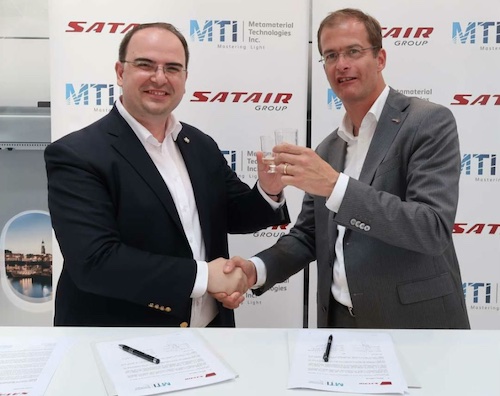
MTI's George Palikaras, founder and CEO (l), and Satair CEO Bart Reijnen (r) sign a distribution agreement at the October 2018 MRO Europe trade show for maintenance, repair and overhaul operations.
The October 2018 agreement widens the market and covers "eyewear and visor products that are developed or manufactured by MTI. These include, without limitation, all sub-components, sub-assemblies, piece parts, software and hardware."
MTI says their technology "is superior to other products currently on the market due to a unique and patented dielectric (non-metallic) optical metamaterial filter, which has been scientifically engineered to ensure that the pilots’ vision and interpretation of the surrounding environment is not disturbed during critical phases of flight."
From an October 17 2018 Metamaterial Technologies Inc. press release
UPDATED: In a February 19 2019 press release, Satair's customer solutions director says initial product applications will appear in the first quarter of 2019. He also said "The technology is highly scalable so it can be customised for a wide variety of platforms and other applications. In commercial aviation the green laser poses the biggest threat because the human eye is more susceptible to the green wavelength. For military markets the red laser may be the largest threat. The advantage of the MTI product compared to other products in the market is that it can be customised to the wavelengths the customer wants to be protected against. As we have exclusive distribution rights across civil aviation, military and defence, we are open to do business with leading OEMs of products such as night vision goggles, head-up displays, helicopter and fighter pilot helmets and aircraft flight deck visors. Other products in the market do not have the same quality, the same level of protection and colour balance that we have.
Thanks to Peter Smith and Leon McLin for bringing the February 2019 press release to our attention.
US: DoD awards nearly $250 million in contracts for pilot laser eye protection
The contracts went to Gentex and to Teledyne Scientific & Imaging, and will be completed by September 2024.
Earlier, on August 10 2018, DoD announced a $49 million contract for the Flash and Laser Airborne Protection System, which provides for research, development and manufacturing of photonic resistant material to protect air crews from flash blindness. Photonic shielding is used on high-value military aircraft such as Air Force One, but is not in widespread use.
The contract went to UES Inc. of Dayton Ohio, and will be completed by November 2024.
According to an October 1 UPI story, "the Pentagon started moving on improved eye protection for pilots after the Chinese military reportedly used lasers against pilots from a base in Djibouti, as well as in the South China Sea."
From UPI (Oct 1 story about Gentex and Teledyne) and UPI (Aug 13 story about UES)
US: Advisory committee recommends pilot procedures, training and glare protection
ARP6378™ has three main parts:
- A description of how lasers can interfere with pilots’ vision and operational performance, and how pilots can reduce adverse effects.
- A recommendation for pilot training, including exposure to safe, simulated laser light in a simulator or other realistic flying environment
- A description of Laser Glare Protection eyewear and windscreen film, with recommendations for whether and how to use these.
The document was developed by the SAE G10OL “Operational Laser” committee over a two-year period. It is available for purchase from SAE for $78. A three-page preview, which includes most of the Table of Contents except the appendices, is here.
From SAE ARP6378™, “Guidance on Mitigation Strategies Against Laser Illumination Effects”, published June 2 2018. Available from SAE.org.
Click to read more...
UK: Professor develops laser-absorbing strip for police face shields; "several thousand" used in Northern Ireland
The strip was developed by John Tyrer of Loughborough University, professor of optical instrumentation. He was commissioned by the Home Office and the PSNI who were concerned about increasing numbers of demonstrators aiming laser pens at police.
The light distracts officers and breaks their positions, according to Tyrer. The orange-tinted film is low-cost and simple to apply.
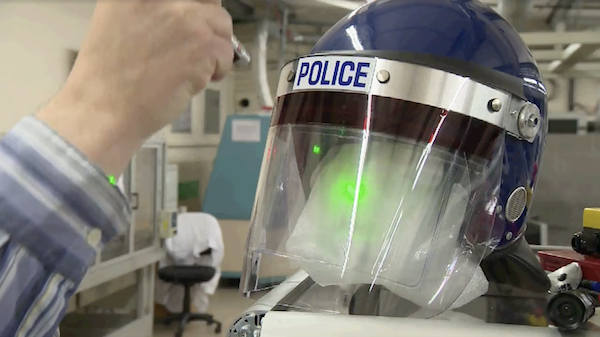
Tyrer demonstrates how light from a laser pen goes through the clear part of the face visor, causing glare and potential eye injury to an officer.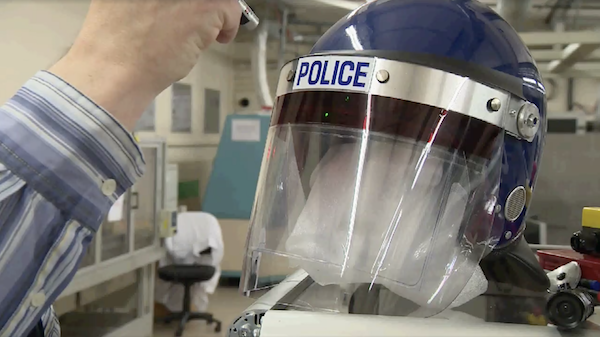
But if the officer tilts his or her head down so the laser goes through the strip, laser light is absorbed and does not present a hazard.
Testing by Public Health England, and real-life usage in Northern Ireland, showed the anti-laser strip to be “very effective”.
Tyrer has also suggested that the same film applied to glasses can protect pilots during takeoffs and landings from any laser activity that might be occurring.
From the Loughborough News Blog and Police Oracle
UPDATE JULY 27 2020: The visor strips are sold by Laser Optical Engineering Ltd. in the U.K. Pricing is £25 (USD $32) per strip in low quantities (<200). According to LOE, in field use it was found that direct attacks on police "stopped quickly" once protesters knew their lasers were ineffective and that laser attackers would be identified and arrested. LOE also sells anti-dazzle glasses. Pricing is £50 (USD $64) each in low quantities (<50).
Additional information about laser use and mis-use at protests, and ways to protect eyes is on the Laser use during protests page.
UK: NPAS says only 1.4% of laser perpetrators were prosecuted
James Cunningham told Police Oracle in a March 21 2018 article that there were a number of reasons for the low prosecution rate, including being not being able to follow the laser perpetrator due to being focused on another job (e.g., completing the original mission).
Also, when lasers are pointed from a tower block area, the helicopter crew may not be able to locate the source.
In 2017 there were 67 incidents [not clear if this is NPAS only], compared with 70 in 2016 and 103 in 2015. Cunningham said the reduction is because NPAS is trying to locate and pursue laser perpetrators, and report the incidents as crime. He said the Laser Misuse (Vehicles) Bill being considered in Parliament is a “step in the right” direction that could lead to more prosecutions.
In December 2017, NPAS purchased laser-reducing glasses which can enable pilots to continue even when illuminated by laser light.
From Police Oracle
US: Marines to buy 1,653 eye-safe laser dazzlers
- An infrared (1535nm) laser rangefinder determines the distance to a person or object. The closer the distance, the lower the laser power output.
- Near-field detection shuts off laser emission if a person or object is too close to the laser output aperture.
- A 3-axis gyroscope detects motion. If the Glare Recoil is suddenly moved, the laser shuts off until stability is resumed and an accurate determination of the distance to a person or object can be re-established: “This prevents hazardous irradiance in situations where Glare Recoil is moving faster than the laser rangefinder can detect objects and dose power output. This results in the prevention of eye hazard danger caused by rapid movement of the device (example: flagging) or improper situational awareness of the operator.”
With these technologies, the laser detects objects or people in the proximity of the beam and then self-adjusts the power output to maintain eye safety. The Nominal Ocular Hazard Distance is said to be 0 meters; the range is 10 feet to 10 miles.
Suggested uses include urban patrolling, cordon and search, crowd control, clearing facilities and security checkpoints.
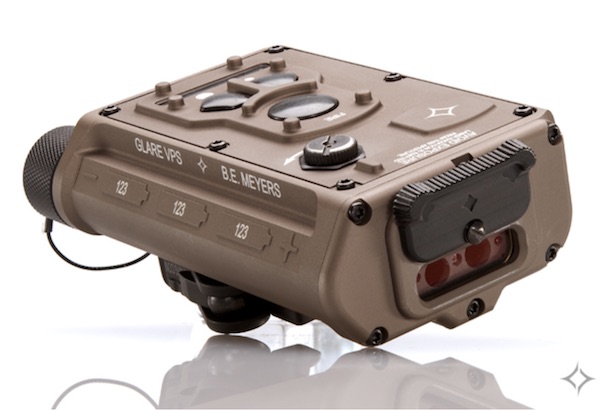
The Glare Recoil is about the size of a Walkman tape player at 5.5” x 3” x 2”. It can mount on a rifle or be handheld.
Meyers also sells a Class 1M “Glare Helios” which has an FDA variance allowing sales to U.S. local, state and federal law enforcement, and U.S. flagged vessels.
From Marine Corps Times, Soldier Systems, and B.E. Meyers. A video produced by the company goes into detail about the specifications and how the person/object detection works.
US: Air Force wants 38,000 more laser eye protection glasses and visors
While the original draft RFP was published for comments on March 27 2018, the revised request takes on additional urgency after the Pentagon on May 3 2018 accused China of aiming lasers at aircraft flying from a U.S. airbase in Djibouti. According to the Pentagon, two pilots had minor, short-term injuries as a result. The next day, China denied using lasers against aircraft in Dijibouti, calling them “groundless accusations.”
The current provider of the Air Force’s laser protection is Teledyne Scientific & Imaging, which was awarded a $30.1 million contract in July 2016 for 11.805 Aircrew Laser Eye Protection (ALEP) Block 2 glasses. The May 2 2018 RFP is for Block 3 glasses and visors. and will provide protection both during the day and at night from laser light.
The RFP’s Requirements Matrix does not specify the exact wavelengths to be blocked. It does say that the night version must have at least 50% visibility (Photopic Luminous Transmittance) and at least 14% for day versions. The document also states:
The ALEP Block 3 will not impair visual performance to the extent that it interferes with safety of flight or mission completion. The device will be visually compatible with the following devices/activities:
- All USAF aircraft
- Joint Helmet Mounted Cueing System (JHMCS); Night Vision Goggles (NVG); Panoramic Night Vision Goggles (PNVG), Helmet Mounted Integrated Targeting (HMIT/HoBiT), and fielded/post- Milestone B visors and aircrew chemical warfare masks
- Canopies/windscreens, HUD, and color cockpit displays
- Detection, recognition, identification, and tracking of targets
- Ability to distinguish terrain colors and geographical features
- Cockpit interior lighting, external aircraft lights, and airfield lights
- Ability to read charts, maps, and other printed materials in the cockpit
- Ability to perform normal aircraft duties in cockpit
From Jane’s 360 and the Air Force Aircrew Laser Eye Protection Block 3 IDIQ Draft RFP. When navigating the FRP webpage, note that there is the Original Synopsis dated March 27 2018 and the “Changed” version dated May 2 2018. There may be subsequent versions as well. The Statement of Work and the Requirements Matrix are the primary documents in the RFP.
Canada: CDN $3M loan to MTI to manufacture laser eye protection glasses
The company’s metaAIR eyewear uses holographic technology to reflect unwanted wavelengths of light while passing others. According to MTI founder and CEO George Palikaras, the clear glasses do not affect vision like current solutions that can be too dark or affect colors.
“What is innovative in our eyewear is that it does not affect the pilot’s vision. So when you put them on you can still see that green is green, blue is blue and red is red,” Palikaras said at a May 4 2018 press conference. In the photo below, Palikaras is wearing the glasses, which reflect some wavelengths but otherwise appear clear to the wearer.
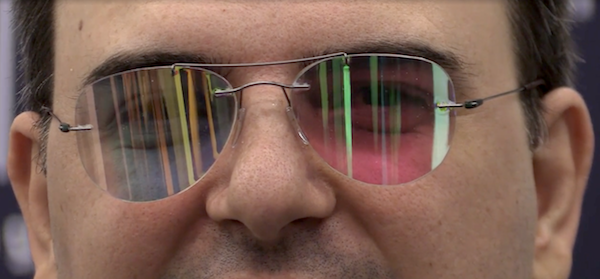
The glasses’ ability to reflect unwanted wavelengths were demonstrated by blocking 99.9% of the green light from a handheld Class 4 (> 500 milliwatts) 532 nanometer laser:
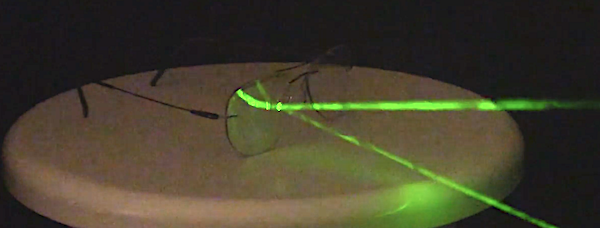
Palikaras said that besides pilots, MTI has had inquiries from the navy and from train operators. He cited incidents involving trains in Germany and Switzerland.
He said the glasses will be sold through MTI’s partner companies and directly to industry buyers.
As of May 2018, MTI has 27 employees, and is looking to hire 15 new full-time employees in production, marketing, research and development. MTI’s holographic technology is also used in developing aircraft windscreens with laser glare protection.
The $3M loan was provided by the Atlantic Canadian Opportunities Agency.
From the Chronicle Herald
Ukraine: Developing countermeasures after 4 cases of laser eye injury
“We already had several such cases (a laser injury of the eye retina) in the State Border Guard Service and in the National Guard. We are now developing countermeasures. We do not fully understand what they use, but we are already working on the instructions what it could be. We will install the appropriate filters, devices, use appropriate glasses,” Avakov said.
He reported on four cases of the laser injury of border guards and national guardsmen.
“The use of such weapons is a barbarous situation. We will discuss it at the international level,” Avakov emphasized.
From Kyiv Post
US: Coast Guard evaluating laser strike protection for cockpit use
The Coast Guard cannot use standard laser eye protection, such as is used in laboratories and industry, because it blocks too much light. One of the options the RDC is looking at is “a flexible optical filter that is reflective of lasers only and has just a slight tint, so it doesn’t interfere with the pilot’s visibility. The material can be applied to any transparent surface, such as the cockpit windshield, to deflect harmful laser beams and prevent them from reaching the inside of the cockpit.”
The chief of the Coast Guard’s Safety Program Management Division indicated eyewear or visors would be short-term solutions, and laser protective coatings for the aircraft would be a long-term solution.
According to Coast Guard information, “[o]nce finalized, the RDC findings will be integrated into an ongoing laser eye protection project the Office of Safety and Environmental Health is conducting in partnership with the Naval Aeromedical Research University in Dayton, Ohio, and the Air Force Research Laboratory at Wright-Patterson Air Force Base in Ohio.”
From a February 21 2018 blog post from the U.S. Coast Guard. Click the “Read more” link for the full blog text. Thanks to George Palikaras for bringing this to our attention.
Click to read more...
UK: UPDATED - BAE Systems developing laser-reducing film for pilots; lab tests successful
According a September 12 2017 BAE press release, a “series of successful laboratory trials have proven our method is effective against a wide range of laser wavelengths.”
BAE researchers told LaserPointerSafety.com: “The film, when installed can be programmed with a number of critical wavelengths (typically three). This film can be upgraded at a later date by either replacing it entirely or adding on a new layer retrospectively to give protection against a new or emerging threat.”
They noted that the film has been measured as having 70% visible light transmission in a multi-wavelength blocking configuration.
The BAE film may be similar in general concept to another film from Metamaterial Technologies Inc. which has been tested by Airbus and is entering the production and deployment stages.
More information about anti-laser windscreen film in general and the MTI version specifically is here.
A press release from BAE is printed below. BAE also made available a graphic with similar information; click the blue “Click to read more…” link to see these.
UPDATED September 13 2017 —We reached out to BAE for additional details about their film; answers are after the press release and graphic.
Click to read more...
UK: Firm developing active optics to block laser light, for use in glasses and visors
It can be integrated into visors, goggles or other eyewear. Below is an “early prototype” showing detectors above the nose bridge and batteries on one earpiece:
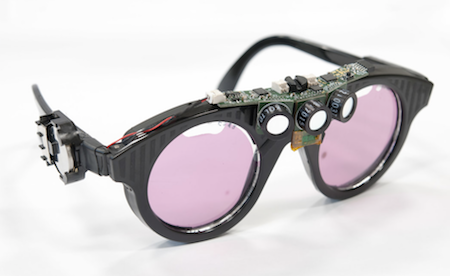
They began work on the “laser dazzle visor” in 2014 and hope to start selling to military, airline suppliers and emergency services in 2018.
From Folium Optics and the Express
Canada: Laser protection windscreen film offered by Airbus subsidiary for civil aviation
Satair Group is a subsidiary of Airbus which offers parts management, service and support for all types of aircraft. Satair expects to receive a Supplemental Type Certificate from the U.S. Federal Aviation Administration, the European Aviation Safety Agency, and Transport Canada Civil Aviation in early 2018. Other jurisdictions will follow.
The metaAIR film was invented and is manufactured by Metamaterial Technologies Inc. (MTI) of Halifax, Nova Scotia. The company previously worked with Airbus to evaluate, verify and test metaAIR for use in Airbus aircraft; initially for the A320 family. The Satair agreement will bring metaAIR to all commercial aircraft including Airbus and Boeing.
From a June 21 2017 MTI press release. For more details, click the link below for an interview with MTI’s George Palikaras, discussing the technology and this agreement.
Click to read more...
Canada: Airbus agrees to commercialize anti-laser windscreen material; eliminates need for laser protective eyewear
The film is not designed to fully block the laser light. It will significantly reduce the glare and temporary flash blindness effects that can occur when a laser is aimed at an aircraft cockpit. This in turn reduces the potential hazard of a laser illumination.
The announcement was made at a February 21 2017 press conference. In a press release kit photo, MTI’s founder and CEO, George Palikaras, demonstrated the laser-reflecting properties by holding up a windscreen that included MTI’s metaAIR film:
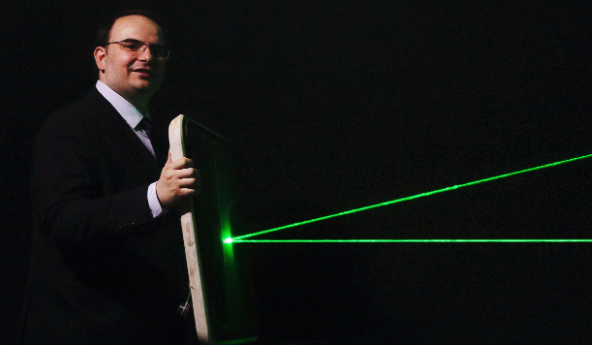
The press release did not indicate a time frame for introduction of the windscreens into service, nor details such as an estimated cost, or aircraft to be outfitted. An Airbus spokesperson did say that there are applications beyond the company’s commercial aircraft division. Palikaras said that metaAIR “can offer solutions in other industries including the military, transportation and glass manufacturers.”
For more detailed information on Airbus’ and MTI’s plans, see this page which includes interview Q&A questions with George Palikaras a few days after the February 21 press conference.
UPDATED April 14 2017: Metamaterials Technologies Inc. closed an $8.3 million round of funding. This will be used to support commercialization of the windscreen film and to add needed staff. MTI can produce metaAIR sheets 80 cm wide by 100 cm long, which is sufficient for standard cockpit windows that are 60 cm wide. However, the process is currently semi-automated and needs to be fully automated. MTI is also looking for new headquarters. From the Chronicle Herald.
UPDATED July 5 2017: MTI will be making its metaAIR anti-laser windscreen film available to non-Airbus aircraft, through aviation parts supplier Satair. An interview with George Palikaras goes into details.
Metamaterial Technologies Inc. issued a press release dated February 21 2017, which is reprinted below.
Click to read more...
US: Bird wearing tiny goggles safely flies through laser beam
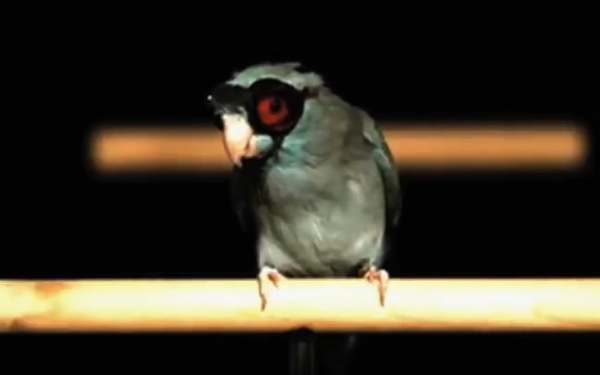
Researchers at Stanford University wanted to get data on how much lift a bird generates. To monitor the wing wake and vortices, they used a laser beam spread by a lens into a plane of light. The light source was a Litron brand double-pumped Neodymium-doped yttrium lithium fluoride (Nd:YLF) laser. The light was green at 527 nanometers, and had a pulse repetition rate of 1 kHz.
A non-toxic mist in the air illuminated the light sheet, just like theatrical fog used at concert laser light shows. As the bird flew through the light, the mist scattered and showed the air patterns, in a technique called “particle imaging velocimetry” or PIV.
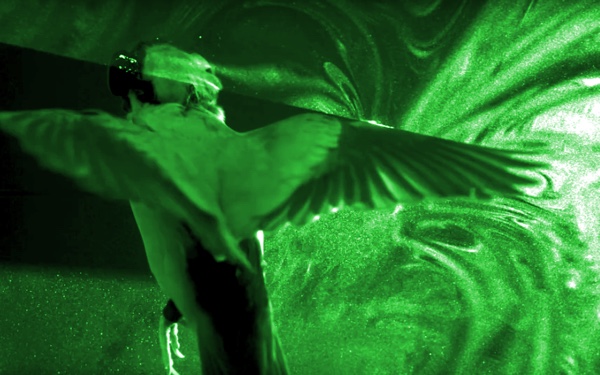
Bird-sized goggles were used to prevent any harm to the bird’s eyesight. The lenses came from human laser safety glasses and had an optical density of 6, meaning that they transmitted only 0.0001% of the laser light. The frame was 3D printed and was held on by veterinary tape. The goggles weighed 1.68 grams, which is roughly 6% of the bird’s body weight (equivalent to 9 pound glasses on a 150 lb. human).
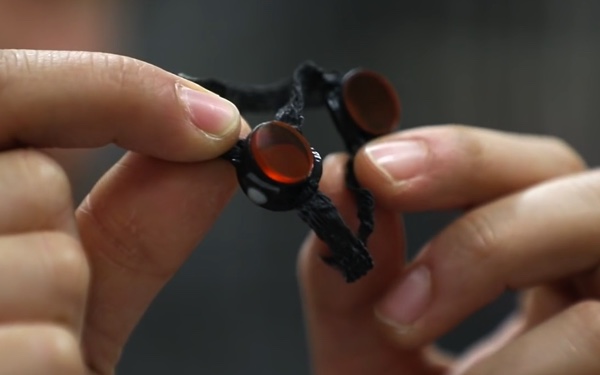
Before beginning the series of experiments, the researchers trained four parrotlets “through many small stress-free steps of habituation.” After “several months of effort” with the birds, only one — a parrotlet named “Obi” — voluntarily flew with the laser goggles. According to the researchers, “[a]ll training and experimental procedures were approved by Stanford's Administrative Panel on Laboratory Animal Care.”
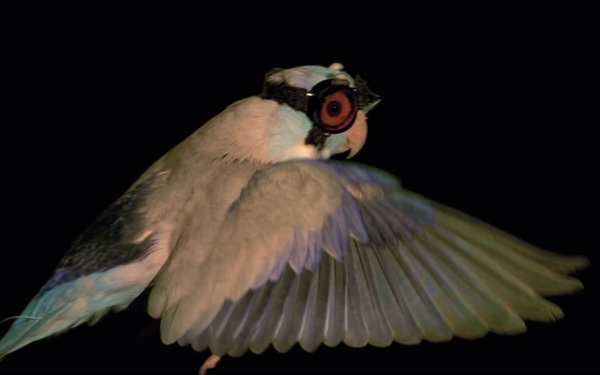
Twelve cameras were used. Four high-speed stereo cameras were for PIV particle motion recording and recorded 4000 frames per flight. Eight cameras were for recording Obi’s wing and head kinematics as it flew from one perch, through the laser light plane, to a landing perch.
The results give “the clearest picture to date of the wake left by a flying animal.” Unexpectedly, the wing tip vortices did not stay stable as happens with aircraft, but instead broke up quickly and violently. This had not been predicted by any previous models.
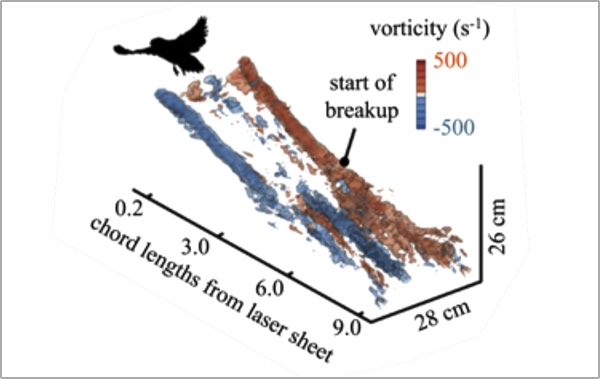
From a Stanford University news story, picked up by numerous websites and news outlets including Popular Mechanics, NBC News, The Verge, Optics.org and many others. The results were published December 6 2016 in the journal Bioinspiration & Biometrics, volume 12, number 1. Thanks to Drs. Ronald K.A.M. Mallant, MSc. for pointing out an error in our description of OD 6 density; the error has been corrected.
UK: Statistics on police helicopter laser attacks; one has been struck 100 times "over the last year"
Assuming “over the past year” means “in the last 12 months”, that would be an average of about two laser illuminations per week.
A separate article from BBC News states that in 2015 there were 91 reported laser illuminations of National Police Air Service aircraft. The largest number was 20 attacks against NPAS helicopters taking off from its Carr Gate headquarters near Wakefield, West Yorkshire.”
Reasons for the apparent discrepancy in numbers are not clear. It may be that South Yorkshire is not a member of the NPAS, which provides centralized air support to local police forces.
The BBC News chart below shows the 2015 NPAS laser attacks:
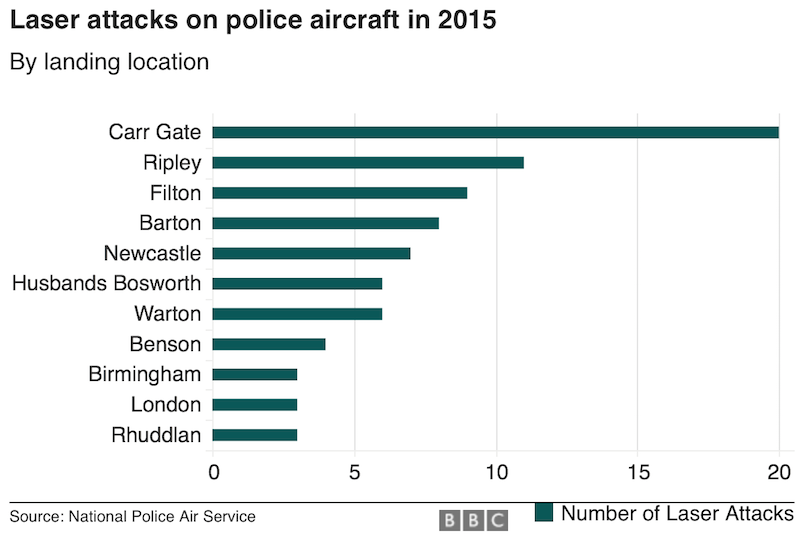
The NPAS is testing laser protective eyewear, as a means to help protect flight crews.
From The Star and BBC News. Interestingly, a September 14 search of the South Yorkshire Police website, to find more information about these incidents and police concern regarding lasers, did not find any results when searching for the term “laser.”
US: Army looking for battlefield goggles which include laser eye protection
The US Army Contracting Center, Aberdeen Proving Ground, Natick Contracting Division (NCD) on behalf of the US Army Natick Soldier Research, Development and Engineering Center (NSRDEC) intends to issue a solicitation under Authority of FAR Part 15 for Research and Development (R&D) efforts to deliver prototype systems capable of meeting Next Generation Eye Protection (NGEP) requirements. Eyewear must be capable of exceeding military ballistic fragmentation protection requirements for eye protection as currently outlined in MIL-PRF-32432, meet optical quality requirements, provide configuration(s) with laser eye protection, accommodate varying light conditions, and be compatible with the Universal Prescription Lens Carrier (UPLC) to accommodate Marines requiring vision correction. Since follow-on production is envisioned, the ability to produce protective eyewear in production quantities is also a key consideration.
The Government is anticipating awarding 1 or more firm fixed price (FFP) contracts with a period of performance of 12 months for the required services. The Government reserves the right to award one or no contracts as a result of the solicitation.
From the pre-solicitation notice at FedBizOpps.gov. The Solicitation Number is W911QY-16-R-0043.
US: Air Force buys 11,805 laser eye protection glasses for $30.1 million
“Air Force aircrew members require an ALEP system for day and night applications that balance requirements for laser eye protection, mission/aircraft compatibility, and flight safety. The ALEP Block 2 system provides aircrew members with enhanced protection against hazard and threat laser devices in combat and training situations while minimizing visual acuity degradation. The ALEP Block 2 system also provides sufficient protection to prevent permanent eye damage and temporary effects (glare, flash blindness, etc.) from laser weapons/devices. The Block 2 system is compatible with current aircrew flight equipment, cockpit/cabin displays, exterior aircraft lights, and airfield lights, night vision devices, helmet mounted displays, and exterior scenery.”
The supplier is Teledyne Scientific & Imaging. The contract amount is $30.1 million, meaning the cost amortized over each spectacle is $2,550. The sole source contract stated “Teledyne is the only firm capable of providing the supplies without the USAF experiencing substantial duplication of cost that could not be expected to be recovered through competition and unacceptable delays in fulfilling its requirements.”
From GovTribe and airforce-technology.com. The federal solicitation number for this contract is FA8606-15-C-6370.
US: New pilot protective "anti-laser" glasses announced
The glasses block three laser wavelengths, in the red, green and blue regions. According to Dr. Perricone, “The real challenge was how do you block out red, blue, and green without changing the color discrimination. It’s critical a pilot sees color. He has to look at his instruments, he has to look at runway lights and a lot of other signals.”
A July 30 2015 news story said the glasses “have been manufactured and are ready for purchase, costing $400 a pair.”
Dr. Perricone was quoted as saying that if pilots are required to wear glasses like these, “then this problem will go away. No one is going to throw rocks at a window that won’t break.”
From WTNH.com
US: Study shows windscreen coatings can reduce laser intensity
More information at the LaserPointerSafety.com page on the 2015 Nanocomposite coating study
Canada: UPDATED - Airbus to test windscreen anti-laser film
Lamda Guard’s “metaAir” film uses metamaterials, also called nano-composites, to reflect one or more laser colors without interfering with normal visibility. According to the company, the film can protect from beam angles up to +/- 50 degrees away from head-on. This has benefits when protecting cockpits against laser strikes, which can come from any angle.
It can be adhesively applied to glass or clear plastic; applications include eyewear, protective goggles and windscreens. Lamda Guard says that the Airbus tests on windscreens will mark the first time an optical metamaterial nano-composite has been applied on a large-scale surface.
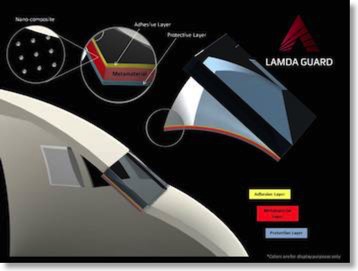
General schematic of metaAir film. Click for larger image.
The metaAir film can be engineered either to absorb or reflect the desired wavelength(s). For aircraft application, the reflection approach is being used in order to block undesired light wavelengths from entering the cockpit. The reflection bandwidth is currently in the 15-20 nanometer range.
For the most common type of green laser pointer -- responsible for 93% of FAA reported incidents in 2013 -- with a wavelength of 532 nm, the film would block light from about 522 to 542 nm. Additional wavelength blocking can be added as well, such as the 445 nm blue used in powerful handheld lasers such as the Wicked Lasers S3 Arctic that has up to 2 watts (2000 milliwatts) output.
Two key advantages of blocking laser light at the windscreen are that pilots do not have to carry or use laser protective eyewear, and there is absolutely no interference with the visibility of aircraft instruments. In preliminary tests, the anti-laser film had a narrow enough bandwidth that it did not interfere with airport lights seen outside a cockpit.
Because of ultraviolet degradation to the adhesive layer that adheres the optical metamaterial to the windscreen, the film would need to be replaced after about 5,000 flight hours. This translates into overnight replacement roughly once every three years. The optical metamaterial itself would not have a flight hour restriction.
In addition to piloted commercial aircraft windscreens, Airbus will also be investigating related applications such as piloted military windscreens, UAV camera protection, and sensor protection for satellites and airborne platforms.
US: Air Force study to help protect pilots from laser injuries
TASC is working on countermeasures such as laser eye protection and the development of procedures for injury assessment. The work is being performed under the Optical Radiation Bioeffects and Safety contract with the Air Force’s 711th Human Performance Wing’s Optical Radiation Bioeffects Branch at Fort Sam Houston in San Antonio, Texas.
From the San Antonio Business Journal
Switzerland: After laser pointer attacks, first responders will have laser protective eyewear
After tests in mid-2013, the Basil Justice and Security Department purchased 1,000 pairs of laser protective eyewear, at 200 Swiss Francs each (USD $224).
All Basel police officers and rescue emergency vehicles are equipped with the glasses, as of December 2013. Other Swiss cantons are in the testing phase.
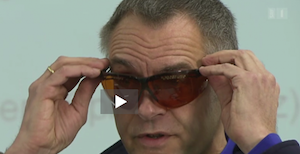
The Basel anti-laser glasses are demonstrated in this frame from a SRF video.
From a December 16 2013 report by Schweizer Radio und Fernsehen, (original German text and Google-translated into English). Thanks to Basel officer Ruedi Maier for bringing this to our attention. For additional news items from Switzerland, including the 2011 purchase of laser protective eyewear for air rescue helicopter pilots, click here.
Canada: Laser strikes up significantly in Edmonton
A police pilot spokesperson said laser users are not reading the packaging which clearly states not to aim at aircraft. After being caught, "There's been a lot of apologies, a lot of regret, some people not realizing the consequences of what they were doing, and then there's been the far opposite -- I can't believe this is happening, this is ludicrous, this isn't serious, it's just a laser pointer."
The pilot also said that a ban is not the answer: "If it's used properly, it's harmless. It's hard to ban something like that, the sale of it completely if 95% of the general public are using it properly."
He noted that not just police aircraft are being lased. Commercial and private aircraft also are at risk.
Edmonton police helicopter pilots are equipped with safety glasses for use during laser illuminations. They have two pair, one to attenuate red laser light and one to attenuate green laser light.
For details on the two most recent Edmonton incidents, on September 6 and 7 2012, see this LaserPointerSafety.com story.
From the Edmonton Journal and Edmonton Sun. Thanks to Keith Murland for bringing this to our attention.
US: Army Research Laboratory works on laser protection for eyes, sensors, etc.
Laser protection team leader Andy Mott was quoted as saying “Lasers of varying pulse width and wavelength are being developed every day. We protect against the known threats, and unknown ones. We develop protection for electronic sensors of the future, as well as the sighting systems of today.”
More details are at the Military.com story
US: Researchers illuminate retinas to help stop laser damage
Because the laser pulse wavelength used was in the infrared, and the cells were cultured (not live retinas) there is no current practical use for pilots and others looking for glasses-free resistance to visible laser light. However, this research may open up other avenues as it does indicate that perhaps the retina can be “hardened.”
Click to read more...
Canada: Iridian announces new anti-laser protection glasses
The LaseReflect Aviator LRG10 glasses are said to mitigate the effects of laser illumination incidents. They reflect more than 99% of 532 nanometer green laser light, the most common color in laser attacks. (According to FAA statistics, about 95% of reported incidents in recent years have involved green light.) They also reflect near-infrared light at 1064 nm, which often is a byproduct of green lasers that are not manufactured with adequate IR-blocking filters. The cost is USD $299.
Custom LaseReflect Aviator glasses are available for specific colors and powers, including multiple wavelengths in a single pair of glasses. For example, blue (405 nm and 445 nm) and red (650 nm) light can also be reflected by the glasses.
Click to read more...
US: Gold-coated nanotech could "laser-proof" pilots' glasses
According to a professor at Embry-Riddle Aeronautical University, gold-tinted eyewear has been used by military pilots for laser protection but only works against certain wavelengths of laser light. However, said Dan Macchiarella, if Thomas’ idea “could be applied to lasers of all strengths and wavelengths, that would certainly be a big advancement.”
A March 10 2013 Orlando Sentinel story noted that funding cuts and competition for grants mean that Thomas’ research faces “some serious hurdles” to develop this idea further. Thomas said finding research money is “going to be very difficult, very difficult.”
From the Orlando Sentinel
Canada: RCMP purchases anti-laser glasses
From Vertical magazine
Click to read more...
Israel: Advanced anti-laser filter announced
It is not clear whether the filter is available at this time (May 2012). The company intends to incorporate it into glasses and night-vision goggles worn by pilots, to protect against flash blindness, meaning power densities from 100 µW/cm² up to 1000 µW/cm².
From Optics.org
UK: Eye test for pilots available from CAA website
The ALESA card is available in hard copy, and can also be downloaded from CAA’s website. If downloaded, the Amsler Grid on the first page should be printed so it is 10 x 10 cm.
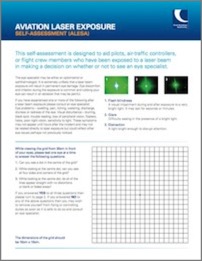
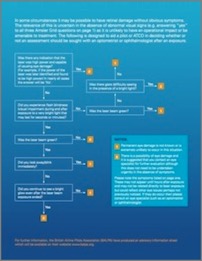
Click for PDF version from CAA ALESA webpage
When staring at the dot in the center of the grid, if the lines appear distorted or there are blank or faded areas, there may be a problem. The person is encouraged to remove themselves from aviation-related duties such as flying or air traffic control, and to see an eye specialist.
The second page has a flowchart of exposure conditions leading either to a “1” meaning unlikely eye damage or a “2” meaning eye damage possibility. If the person scores a “2”, the flowchart suggests they see an eye specialist.
From PilotWeb and the CAA ALESA webpage. The CAA press release about ALESA is here.
US: Air Force spending $2,400 each, for 3,000+ laser protection glasses
[NOTE: The amounts above represent about $2,400 per pair of laser protection spectacles. More information about anti-laser glasses for pilots, including non-military versions protecting against one or two visible wavelengths for roughly $100-200, is here.]
From a Teledyne Technologies press release
Switzerland: Air rescue pilots to use laser protective eyewear
The action was taken because laser attacks are on the rise: six in 2009, 11 in 2010 and 16 to mid-October in 2011.
The sale of strong laser pointers was banned in Switzerland in May. The Federal Health Office is currently reviewing the possibility of banning their possession and use. Checks carried out by the Federal Office of Metrology this year showed that more than 95 per cent of the pointers tested were stronger than the permitted limit.
From SwissInfo.ch
US: St. Louis area sheriff's department to use anti-laser glasses
The eyewear, made by NoiR, significantly reduces laser light, without adversely affecting pilot vision of cockpit instruments or airport lights. Because some laser light is transmitted, pilots and flight officers will still be able to track the source of a laser illumination.
The decision to purchase the glasses was made because of recent laser incidents in the St. Louis area. A spokesperson said the eyewear is “another tool to keep us in the air.”
From STLtoday.com